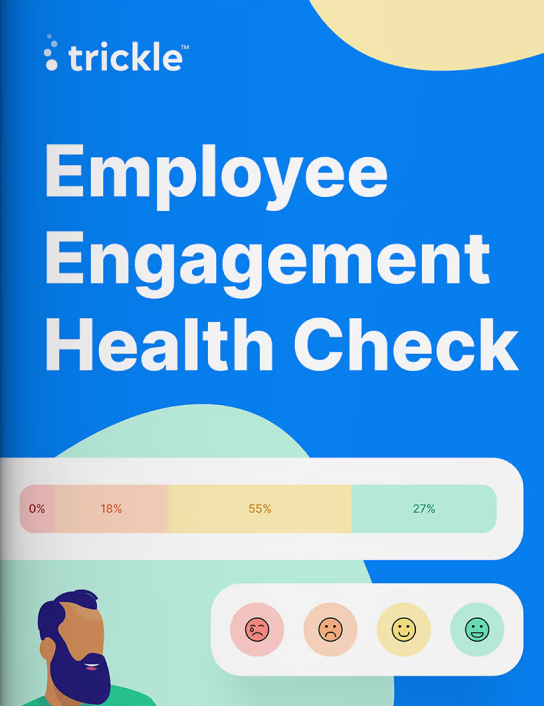How well does your company engage its employees?
Take your health check and find out.


Some of the most common reasons why employees leave their jobs include employees feeling underappreciated, bad management, and an inadequate salary. Replacing them isn’t easy, and recruitment is expensive. The average cost of recruiting a new employee is £3,000. The cost of an employee leaving and replacing them with a new person is approximately £30,000.
These numbers don’t include the intangible value of potential disruption to the internal culture, processes and employee harmony.
All of these costs and disruptions are amplified when it’s one of your top employees that leaves. Retention is cheaper than recruitment in a similar way that prevention is often better than the cure. So, what can you do to try and stop your top talent leaving? Read on, and we’ll give you some tips.
The employee experience is everything. Employees and customers are equally important — having either side dissatisfied with their experience can threaten the viability of your business. However, if your employees are having a good time, they’ll often be more productive and less likely to leave.
Your employee’s experience should be integrated into your overall business strategy. Siloing this into a separate function can mean that you’re essentially disconnecting your people from your business.
If you can trust your employees to get their work done in different locations and/or at different times of the day, it can enhance their working experience. Flexible working can help your staff have a better balance between work and life. Their financial situation can also be improved as they can reduce commuting costs and potentially live in more affordable locations.
A company’s culture is vital to its success. All employees want to be in a healthy, positive culture that helps them to perform at their best as well as empowering them to be the best version of themselves holistically. Ensuring that everyone helps to build the culture, which increases cultural buy-in, can make employees feel part of something bigger than themselves.
Employees have their own personal goals when they are working. A good business should try their best to align their personal career goals with the business goals. It’s also important that the CPD plan is specific to each individual person. This can help staff to feel as though the company is helping them do more than just pay their bills.
Personalised recognition is vital to retaining top talent. Rewards for good performance need to be suited to the individual. Otherwise, they can demotivate your employees. Not everyone wants to win literal gold for their performance, but they do want to receive their own version of golden recognition for great work. Making the recognition specific to each employee makes them feel more valued as a human being, outside of just their job role.
As we mentioned before, a lot of employees end up quitting their jobs because of issues with their bosses. Ensuring that all management staff have adequate training and experience in managing people is crucial to keeping your top-performing staff members.
Those in managerial positions are normally the people who help to drive the company culture. If they aren’t up to the task, then the whole ‘house of cards’ could end up crumbling.
Employers need to be comfortable with receiving negative employee feedback. It can help to prevent minor problems from becoming bigger issues. It’s vital that if this tactic is to be implemented, it’s done so properly. This means the following:
Allowing anonymous feedback – The focus should be on what the message is, not the messenger. Enabling employees to give anonymous feedback using platforms like Trickle keeps the focus solely on the problem. This increases the likelihood of employees voicing their honest opinions about things without the fear of being labelled anything negative.
Acting on feedback – Knowledge isn’t power unless it’s acted upon. Simply gathering data from employees and sitting on it won’t help anyone. It’s important that the senior management team put into place clear actions as a result of the feedback they receive. The more this happens, the more honest the feedback will be, making it more valuable to the company.
Regular opportunities to give feedback – Annual surveys are no longer good enough, they aren’t designed for modern workplaces — a lot can change in a year.
Regular check-ins are more effective, as it allows employers to know how their employees are doing, as well as being able to see if the actions applied after previous feedback was effective.
Employees must also feel comfortable starting a conversation about any improvements or concerns they may have.
Having a strategy specifically designed to retain employees is a great way to… retain employees. Implementing the tips we’ve mentioned in this article into a clear strategy can go a long way to ensuring that your churn rate is reduced. Any employee retention strategy needs to be fully integrated into the overall business plan, as siloing it will take away a lot of its effectiveness.
Retaining top talent is hard work, but the rewards are definitely worth it. Increased productivity, happy employees, higher retention rates, and increased profits are just some of the benefits of keeping your top performers for longer. All good things must come to an end at some point, but it’s about how the journey ends.
Knowing that you did everything you could to keep your employees happy and that they’d happily recommend you to someone who could replace them signals a job well done on your part.
Trickle helps you to do this by enabling employee feedback, increasing the types of recognition, figuring out how people are feeling and much more.
Click the link below to get your free demo today.